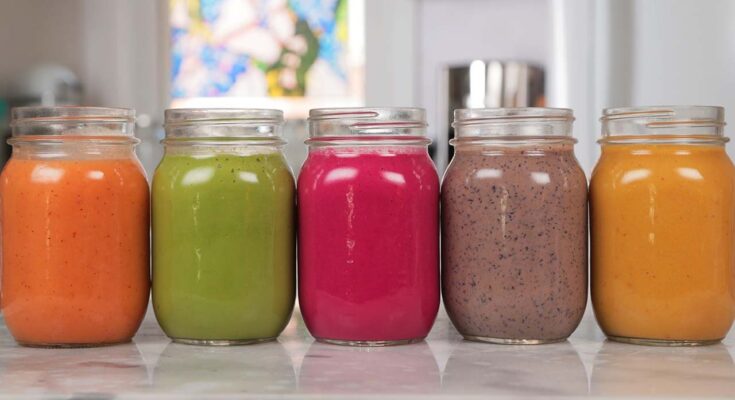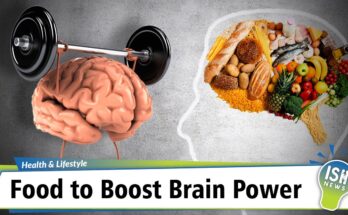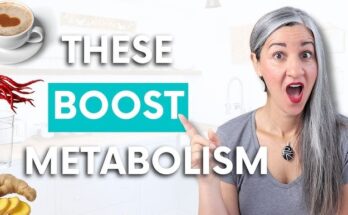Smoothie Recipe: Smoothies have taken the world by storm, becoming a go-to beverage for health enthusiasts and busy individuals alike. These delicious, nutrient-packed drinks offer a quick and easy way to consume vitamins, minerals, and antioxidants while satisfying your taste buds.
What Are Smoothies?
A smoothie is a blended drink made by combining fruits, vegetables, liquids, and optional add-ins like protein powders, seeds, or nut butter. Unlike juices, smoothies retain fiber, making them more filling and nutrient-dense. They can be customized to suit any dietary preference, making them a versatile option for breakfast, snacks, or post-workout meals.
Why Are Smoothies So Popular?
Smoothies are incredibly popular because they are easy to prepare, customizable, and portable. They’re perfect for busy mornings or as a post-workout refreshment. Plus, their nutrient-packed composition helps support energy levels, digestion, and weight management. Whether you’re looking for a detox drink or a protein-packed snack, smoothies fit the bill.
Health Benefits of Smoothies
Smoothies do more than just taste great—they deliver an array of health benefits that make them a staple in many diets.
Nutritional Advantages
Smoothies provide a rich source of vitamins, minerals, and antioxidants. The fruits and vegetables used often contain high levels of vitamin C, potassium, and fiber, promoting better digestion and immune health. They also deliver hydration, especially when made with coconut water or almond milk.
Weight Loss and Detox Benefits
Smoothies are excellent for weight loss because they can be low in calories yet filling due to their fiber content. Detox smoothies, in particular, use ingredients like spinach, kale, and lemon, which help flush out toxins and boost metabolism. Adding protein and healthy fats ensures they keep you full for longer, reducing cravings throughout the day.
Essential Ingredients for a Smoothie
Crafting the perfect smoothie starts with selecting the right ingredients.
Fruits and Vegetables
- Fruits: Bananas, berries, mangoes, pineapples, and apples are great for sweetness and texture.
- Vegetables: Leafy greens like spinach and kale add nutrients without overpowering the flavor. Cucumbers and carrots are also popular options.
Liquid Bases and Their Benefits
- Water: Hydrating and calorie-free.
- Milk (dairy or plant-based): Adds creaminess and protein.
- Coconut Water: Low-calorie and rich in electrolytes.
- Juice: Provides flavor but can add sugar, so use sparingly.
Protein and Healthy Fat Add-ons
- Protein Sources: Greek yogurt, protein powders, or silken tofu.
- Healthy Fats: Avocados, chia seeds, flaxseeds, nut butters, and coconut oil provide sustained energy and keep you full longer.
Tools and Equipment Needed
To create a smoothie that’s smooth and lump-free, having the right tools is essential.
Best Blenders for Smoothies
Invest in a high-powered blender, such as a Vitamix or NutriBullet, to handle frozen fruits and tough ingredients like kale and nuts. Personal-sized blenders are also great for single servings and portability.
Measuring Tools and Storage Jars
Measuring cups and spoons help maintain the right proportions. Mason jars and reusable bottles are ideal for storing and carrying smoothies.
Preparing Ingredients Before Blending
Proper preparation ensures smooth blending and better flavors.
Washing and Chopping Fruits and Veggies
Always wash fresh produce thoroughly to remove pesticides and dirt. Chop larger fruits and vegetables into smaller pieces for easier blending.
Freezing Ingredients for Convenience
Freezing fruits and vegetables not only preserves nutrients but also gives your smoothie a thicker, colder texture. Pre-pack ingredients into freezer bags for quick access during busy mornings.
Step 1 – Choose Your Base Liquid
The first step in making a smoothie is selecting the right liquid base. This ingredient sets the foundation for texture, consistency, and flavor.
Options for Milk, Juice, and Water
- Milk Options:
- Dairy Milk: Provides creaminess and is rich in calcium and protein. Ideal for post-workout smoothies.
- Almond Milk: A low-calorie, plant-based alternative that’s lactose-free.
- Coconut Milk: Offers a tropical flavor and is packed with healthy fats.
- Juices:
- Orange Juice: Adds natural sweetness and vitamin C.
- Apple Juice: Mild and sweet, but use sparingly due to its sugar content.
- Water and Coconut Water:
- Water: Keeps the calorie count low while maintaining hydration.
- Coconut Water: Excellent for hydration and electrolytes, perfect after workouts.
- Yogurt or Kefir:
- Adds probiotics for gut health and thickens the smoothie.
Tip: Start with 1 cup of liquid and adjust later if needed to reach your desired consistency.
Step 2 – Add Fruits and Vegetables
Now that the base is ready, it’s time to add fruits and vegetables to build flavor and nutrition.
Best Combinations for Flavor and Nutrition
- Fruits:
- Bananas: Creamy texture and natural sweetness.
- Berries (Strawberries, Blueberries, Raspberries): Antioxidant-rich and vibrant.
- Mango and Pineapple: Tropical flavors and high vitamin C content.
- Apples and Pears: Fiber-rich and mild in flavor.
- Vegetables:
- Spinach and Kale: Nutrient-dense greens that blend well.
- Carrots: Slight sweetness and rich in beta-carotene.
- Cucumbers: Hydrating and low-calorie, adding a refreshing taste.
- Tips for Balancing Flavors:
- Pair sweet fruits like bananas with tart berries.
- Add greens sparingly to avoid overpowering the flavor.
- Use frozen fruits for a thicker, creamier texture.
Pro Tip: Pre-cut and freeze your fruits and vegetables to save time and enhance the smoothie’s chill factor.
Step 3 – Boost with Protein and Superfoods
Adding proteins and superfoods can elevate your smoothie’s nutritional value, making it more filling and functional.
Adding Seeds, Nut Butter, and Powders
- Protein Sources:
- Protein Powders: Whey, pea, or soy protein to support muscle growth.
- Greek Yogurt: High in protein and probiotics for gut health.
- Tofu: Silken tofu blends easily and is great for vegans.
- Healthy Fats:
- Nut Butters (Almond, Peanut, or Cashew): Adds richness and satiety.
- Avocados: Creamy texture with heart-healthy fats.
- Seeds (Chia, Flax, Hemp): Boosts omega-3s and fiber.
- Superfoods:
- Spirulina: A nutrient-dense algae powder.
- Matcha Powder: Contains antioxidants and boosts energy.
- Cacao Nibs: Adds crunch and a chocolatey flavor rich in antioxidants.
Tip: Combine 1–2 protein or fat sources and 1 superfood to avoid overpowering flavors.
Step 4 – Sweeteners and Flavor Enhancers
Sometimes, smoothies need a little extra sweetness or flavor boost. Natural options are better than refined sugars.
Natural Sweeteners and Spices
- Sweeteners:
- Honey or Maple Syrup: Provides natural sweetness without processed sugars.
- Dates: Fiber-rich and naturally sweet—perfect for thick smoothies.
- Stevia or Monk Fruit: Low-calorie options for diabetics or low-carb diets.
- Flavor Enhancers:
- Vanilla Extract: Adds a smooth, warm flavor.
- Cinnamon or Nutmeg: Great for spiced smoothies and detox blends.
- Cocoa Powder: Adds chocolate flavor without extra sugar.
Pro Tip: Taste the smoothie before adding sweeteners—you might not need them if your fruits are naturally sweet.
Step 5 – Blending Techniques
Blending is where the magic happens. Getting the technique right ensures a smooth, lump-free drink every time.
Blending Time and Speed Settings
- Layering Ingredients Correctly:
- Start with liquids, followed by soft ingredients (yogurt, nut butter), and then fruits or vegetables. Add frozen ingredients and ice last.
- Blending Tips:
- Low Speed First: Begin blending on low to break down larger pieces.
- High Speed Last: Gradually increase to high speed for a smooth finish.
- How Long to Blend:
- Blend for 45–60 seconds or until smooth.
- Pause and scrape down the sides if needed.
- Troubleshooting Blending Issues:
- Too Thick? Add more liquid gradually.
- Too Thin? Add more frozen fruit or ice cubes to thicken.
Pro Tip: Use the pulse function for chunkier smoothies or smoothie bowls.
Step 6 – Tasting and Adjusting Flavor
Before serving, give your smoothie a taste test.
- Too Tart? Add honey or bananas.
- Too Sweet? Add a squeeze of lemon juice or extra greens.
- Too Thick? Blend in more liquid.
- Not Flavorful Enough? Sprinkle spices or add a dash of vanilla.
Tip: Always taste and adjust before pouring into glasses or jars.
Step 7 – Serving and Garnishing
Presentation matters, even for smoothies!
Creative Presentation Ideas
- Glassware:
- Serve in mason jars, tall glasses, or smoothie bowls for Instagram-worthy presentations.
- Garnishes:
- Fresh fruits, mint leaves, or coconut flakes on top.
- Chia seeds or cacao nibs for added crunch.
- Straws and Toppings:
- Use colorful reusable straws and layer toppings for added appeal.
Pro Tip: Sprinkle garnishes after pouring to avoid sinking.
Popular Smoothie Recipes to Try
Smoothies come in countless varieties, catering to different tastes and dietary preferences. Here are a few tried-and-tested recipes to inspire your next blend.
Green Detox Smoothie
Ingredients:
- 1 cup spinach or kale (fresh or frozen)
- 1 green apple, cored and chopped
- 1/2 cucumber, sliced
- 1/2 lemon, juiced
- 1 tablespoon chia seeds
- 1 cup coconut water
- A handful of ice cubes
Instructions:
- Add the coconut water as your base liquid.
- Toss in the leafy greens, apple, cucumber, and lemon juice.
- Sprinkle the chia seeds and add ice cubes.
- Blend on high speed until smooth.
- Taste and adjust sweetness with a touch of honey if needed.
Benefits:
This smoothie is loaded with fiber, antioxidants, and vitamin C. It’s perfect for detoxing and boosting hydration.
Tropical Paradise Smoothie
Ingredients:
- 1 cup frozen mango chunks
- 1/2 cup pineapple chunks
- 1 banana
- 1 cup coconut milk
- 1 tablespoon shredded coconut
- A handful of ice cubes
Instructions:
- Pour coconut milk as the base liquid.
- Add mango, pineapple, and banana for tropical sweetness.
- Toss in the shredded coconut and ice.
- Blend until creamy and smooth.
- Garnish with extra shredded coconut and serve.
Benefits:
This tropical treat is rich in vitamin C, potassium, and healthy fats, offering a burst of energy.
Protein Power Smoothie
Ingredients:
- 1 cup almond milk
- 1 scoop protein powder (vanilla or chocolate)
- 1 banana
- 2 tablespoons peanut butter
- 1 tablespoon cocoa powder
- 1 teaspoon honey
- A handful of ice cubes
Instructions:
- Add almond milk as the base.
- Blend the banana, peanut butter, protein powder, and cocoa powder.
- Toss in honey for sweetness and ice for texture.
- Blend until smooth and creamy.
- Pour into a glass and top with cocoa nibs or crushed nuts.
Benefits:
Packed with protein and healthy fats, this smoothie is perfect for muscle recovery and keeping hunger at bay.
Tips to Store Leftover Smoothies
Sometimes, you might make more smoothie than you can finish. Storing leftovers properly ensures you can enjoy them later without losing flavor or nutrients.
Refrigerating Smoothies
- Store smoothies in airtight glass jars or bottles to preserve freshness.
- Fill containers to the top to reduce air exposure and prevent oxidation.
- Shake well before drinking, as separation may occur.
How Long Can Smoothies Last in the Fridge?
- Fresh smoothies can last up to 24–48 hours in the refrigerator.
Freezing Smoothies
- Pour smoothies into ice cube trays or freezer-safe bags.
- Freeze and blend again when ready to drink.
- Smoothies can last up to 3 months in the freezer.
Pro Tip: Label containers with the date to track storage time.
Troubleshooting Common Smoothie Problems
Smoothies don’t always turn out perfect, but most problems can be fixed quickly.
Fixing Thick or Thin Consistency
- Too Thick? Add more liquid (water, juice, or milk) and blend again.
- Too Thin? Add more frozen fruits, ice, or a banana to thicken it.
Enhancing Bland Flavors
- Add natural sweeteners like honey, maple syrup, or dates.
- Boost flavor with vanilla extract, cinnamon, or citrus juice.
Pro Tip: Always taste-test your smoothie before serving and tweak the ingredients as needed.
FAQs about Smoothie Recipe
What ingredients do I need for a basic smoothie?
A basic smoothie typically requires fresh or frozen fruits such as bananas, strawberries, or blueberries, liquid like milk, juice, or yogurt, and optional sweeteners or flavor enhancers like honey or vanilla extract.
Can I use frozen fruit in smoothies?
Yes, frozen fruit is excellent for smoothies. It helps keep the smoothie cold and thick without the need for added ice.
How can I make my smoothie more nutritious?
Enhance your smoothie’s nutritional value by adding spinach, kale, protein powder, seeds like chia or flax, or a scoop of nut butter.
What is the best way to thicken a smoothie?
To thicken a smoothie, you can add more frozen fruits, a handful of oats, some yogurt, or even a small amount of avocado for a creamy texture.
Can I make smoothies ahead of time?
While smoothies are best enjoyed fresh, you can make them up to 24 hours in advance and store them in the refrigerator. Shake or stir well before drinking, as separation may occur.
Are smoothies suitable for weight loss?
Smoothies can be a part of a weight loss diet if you monitor the ingredients to ensure they’re low in calories and sugars but high in nutrients and fibers. Avoid adding too much sweetener or high-calorie ingredients.
Conclusion
Smoothies are a fantastic way to enjoy a quick, nutritious meal or snack. With endless ingredient combinations, you can customize them to suit your taste, dietary needs, and health goals. From detox blends to protein-packed options, smoothies fit seamlessly into any lifestyle.
By following this step-by-step guide, you’ll master the art of making smoothies, ensuring each blend is flavorful, nutrient-rich, and perfectly textured. Whether you’re new to smoothies or a seasoned blender, these recipes and tips will keep your smoothie game strong.



